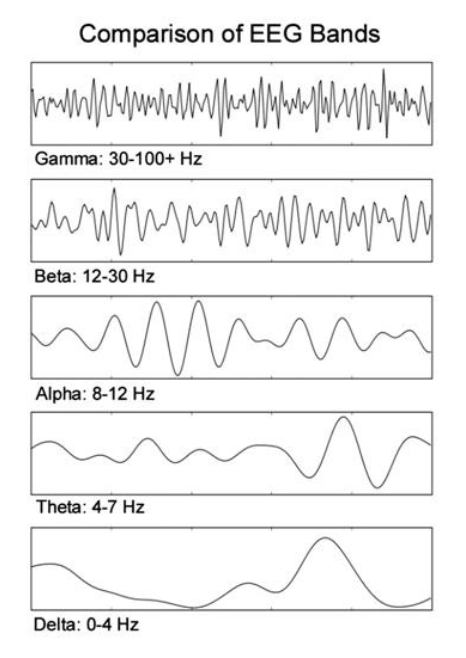 In our previous blog, we introduced the idea of EEG frequency bands, which can basically be described as a fixed range of wave frequencies and amplitudes over a time scale. These bands are components of the overall EEG waveform captured at an electrode. Scientists use mathematical models such as Fast Fourier Transforms to extract the band information from the overall EEG waveform.
In our previous blog, we introduced the idea of EEG frequency bands, which can basically be described as a fixed range of wave frequencies and amplitudes over a time scale. These bands are components of the overall EEG waveform captured at an electrode. Scientists use mathematical models such as Fast Fourier Transforms to extract the band information from the overall EEG waveform.
In the figure to the right, you’ll find the five most common EEG bands and their frequency ranges. Scientists have assigned Greek letters to these bands: delta, theta, alpha, beta and gamma. As you can see, these bands are all very distinct, from the slow roll of the delta wave to the hyperactivity of the gamma wave, and everything in between.
The Rhythm of Neurons
A neuron may electrically oscillate on and off in a rhythmic pattern, and sometimes multiple neurons in a neural ensemble (neurons that work together on a particular neural computation) oscillate together in a synchronized way. When enough neurons oscillate together at a given frequency, this gives rise to large-scale, macroscopic oscillations that are significant enough to be detected by an EEG. The higher the amplitudes of the waves, the larger the macroscopic oscillations detected.
To put this in real world terms, consider the following: Suppose you are visiting New York and decide to attend a NY Philharmonic (neural ensemble) concert. Each musician (neuron) involved has practiced with the other Philharmonic members on each piece of music (neural computation), and when the performance is set to begin, the pianist plays a note that emits a singular sound (oscillation). As they play on, you begin to recognize elements of the orchestral piece. When all of the musicians play together from the musical score (synchronization), you now fully recognize the piece of music, which is being played at its optimum tempo (rhythm).
Understanding How We Think
Researchers have diligently analyzed waveforms in order to better understand “how” humans think, and neural oscillation patterns and frequency bands have provided some insight into this. For example, certain oscillations are linked to memory functions, especially theta waves. Without going into complex details, here is a scaled-down summary (found on www.mentalhealthdaily.com**) of how scientists believe the bands broadly map to mental and emotional activity.
Gamma Waves
- Too much: Anxiety, high arousal, stress
- Too little: ADHD, depression, learning disabilities
- Optimal: Binding senses, cognition, information processing, learning, perception, REM sleep
Beta Waves
- Too much: Adrenaline, anxiety, high arousal, inability to relax, stress
- Too little: ADHD, daydreaming, depression, poor cognition
- Optimal: Conscious focus, memory, problem solving
Alpha Waves
- Too much: Daydreaming, inability to focus, too relaxed
- Too little: Anxiety, high stress, insomnia, OCD
- Optimal: Relaxation
Theta Waves
- Too much: ADHD, depression, hyperactivity, impulsivity, inattentiveness
- Too little: Anxiety, poor emotional awareness, stress
- Optimal: Creativity, emotional connection, intuition, relaxation
Delta Waves
- Too much: Brain injuries, learning problems, inability to think, severe ADHD
- Too little: Inability to rejuvenate body, inability to revitalize the brain, poor sleep
- Optimal: Immune system, natural healing, restorative / deep sleep
Neural Rhythm: Music to Your Ears (and Brains!)
Let’s return to the orchestra for a moment. Suppose the pianist did not adequately practice before the performance, or had the flu that day, or did not tune the piano before the concert; the orchestral piece (neural computation) wouldn’t sound right (non-optimal), resulting in disharmony (poor synchronization or rhythm) among the other musicians. As with most things to do with the human body, different parts need to be working together in concert for optimal results. Unfortunately, not all humans have perfect orchestras inside their heads all of the time.
Picture source: http://psychedelic-information-theory.com/eeg-bands



